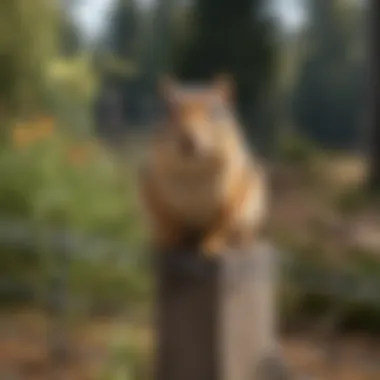Effective Strategies to Eliminate Chipmunks from Your Home


Preventive Pest Control Strategies
When it comes to effectively ridding your home of chipmunks, preventive pest control strategies play a crucial role in maintaining a pest-free environment. Firstly, focusing on securing your house's exterior is essential. Seal any cracks in the foundation or walls that may serve as entry points for chipmunks. Regularly clearing debris around your property helps eliminate hiding spots for pests and reduces the likelihood of chipmunks finding their way in. Implementing measures to prevent pests from entering your home, such as installing mesh screens on windows and doors, can act as a barrier against chipmunk intrusions.
In addition to safeguarding the exterior of your home, maintaining a well-kept yard is paramount in preventing chipmunk infestations. Establish essential yard care routines, including mowing the lawn regularly and trimming bushes and vegetation near your house. By keeping your yard tidy and free of clutter, you deter chipmunks from nesting in the vicinity. Employing methods to keep your yard pest-free, such as removing standing water and eliminating food sources that attract chipmunks, adds an extra layer of protection to your property.
Indoor cleanliness also plays a significant role in chipmunk prevention. Employ expert cleaning tips and techniques to maintain a hygienic indoor environment, as chipmunks are less likely to inhabit clean spaces. Regularly vacuuming, dusting, and decluttering can help minimize potential hiding spots for pests. Ensuring that food is stored in airtight containers and promptly cleaning up spills reduces the attractiveness of your home to chipmunks and other pests.
Garbage disposal is another critical aspect of pest control. Implement efficient waste disposal methods, such as using sealed trash bins and disposing of garbage regularly. Proper garbage disposal not only minimizes odors that may attract chipmunks but also reduces the abundance of food sources that sustain their presence. By prioritizing the secure containment and removal of trash, you enhance the overall pest resistance of your home.
Moreover, exploring innovative ways to safeguard your home against chipmunks and other pests can provide added protection. Consider incorporating natural deterrents, such as planting mint or lavender around your property, as their scents repel chipmunks. Utilizing ultrasonic devices that emit high-frequency sound waves can also deter pests without harming them. By combining various preventive pest control strategies, you can create a hostile environment for chipmunks and safeguard your home effectively.
Understanding Chipmunk Behavior
Understanding chipmunk behavior is crucial to effectively eliminate these pests from your home. By diving into their behavioral patterns and instincts, homeowners can develop strategic approaches to tackle infestation issues. Chipmunks are small, agile rodents known for their burrowing and nesting habits, which can lead to property damage if left unchecked. Understanding how these creatures operate, from their nesting to foraging behaviors, is key to implementing successful eradication strategies.
Identification of Chipmunks
Physical Characteristics
Chipmunks are easily identifiable by their small size, striped patterns across their backs, and bushy tails. These physical characteristics aid in distinguishing chipmunks from other rodent species, making it easier to pinpoint their presence on your property. Their quick movements and acrobatic abilities enable them to scurry through gardens and structures with ease, presenting challenges for homeowners looking to deter them.
Habitat Preferences
Chipmunks prefer habitats with ample ground cover, such as gardens and yard spaces with plenty of foliage and debris. These areas provide ideal protection and food sources for chipmunks, fostering breeding and nesting opportunities. Understanding these habitat preferences allows homeowners to target specific areas for prevention and removal efforts, effectively disrupting chipmunks' comfort zones.
Common Nesting Locations
Garden Areas
Within garden areas, chipmunks often seek out dense shrubbery, flower beds, and fallen leaves as prime nesting spots. These locations offer both shelter and food sources, making gardens attractive to chipmunks looking to establish nests. Homeowners must be vigilant in checking and clearing these areas to prevent chipmunks from settling in and causing damage to plants and structures.
Structural Entry Points
Chipmunks can access structures through small openings in foundations, walls, and roofs, posing a risk of indoor infestations. Identifying and securing these entry points is crucial in preventing chipmunks from entering homes and buildings. By fortifying vulnerable spots with wire mesh or patching cracks and holes, homeowners can create barriers that discourage chipmunks from encroaching on indoor spaces.


Feeding Habits of Chipmunks
Preferred Foods
Chipmunks have a preference for nuts, seeds, fruits, and insects, showcasing an omnivorous diet. Their ability to forage both above and below ground allows them to locate and harvest a variety of food sources. By understanding chipmunks' favored foods, homeowners can adjust landscaping practices and storage methods to minimize attractants and deter these pests.
Foraging Patterns
Chipmunks exhibit diurnal feeding habits, actively searching for food during daylight hours. Their agile foraging patterns involve collecting and storing food in underground burrows for future consumption. By observing these behaviors, homeowners can identify areas of high activity and implement targeted strategies to disrupt foraging patterns, reducing chipmunk presence on their properties.
Preventive Measures
Preventive measures play a crucial role in effectively ridding chipmunks from your home. By proactively taking steps to prevent chipmunks from entering your living space, you can avoid potential infestations and damage to your property. Implementing preventive measures not only protects your household but also promotes a safe and healthy environment for your family. It is essential to focus on seal entry points and remove attractants to deter chipmunks from settling in your home.
Seal Entry Points
Sealing entry points is a fundamental aspect of preventing chipmunks from gaining access to your home. Addressing issues such as patching holes and cracks in your foundation or walls is essential to create a barrier that deters these pests. Patching holes and cracks not only prevents chipmunks from entering but also helps maintain the structural integrity of your home. By utilizing materials such as foam insulation or caulk, you can effectively seal off potential entryways for chipmunks.
Install Wire Mesh
Another effective method to seal entry points is by installing wire mesh. This durable material acts as a physical barrier, preventing chipmunks from burrowing or entering through gaps in walls or vents. Wire mesh is a popular choice for preventing chipmunk intrusion due to its versatility and durability. It provides a long-lasting solution to keep these pests at bay and is relatively easy to install in various entry points around your home.
Remove Attractants
In addition to sealing entry points, removing attractants is essential to discourage chipmunks from being drawn to your property. By securing garbage bins with tight-fitting lids, you can reduce access to potential food sources that may attract chipmunks. Properly storing food in airtight containers also prevents these pests from being lured by easily accessible meals. By removing attractants, you actively decrease the likelihood of chipmunks seeking shelter or food in and around your home.
Secure Garbage Bins
Securing garbage bins is a crucial step in preventing chipmunks from rummaging through trash in search of food. By using bins with locking mechanisms or placing heavy weights on bin lids, you can minimize the risk of attracting chipmunks with food waste. Keeping garbage bins tightly sealed not only deters chipmunks but also helps maintain a clean and hygienic outdoor environment.
Store Food Properly
Properly storing food is another vital preventive measure to avoid enticing chipmunks into your home. By storing food in sealed containers or cabinets, you eliminate easy access for pests seeking food sources. This practice not only protects your food supply from contamination but also reduces the likelihood of chipmunks exploring your home in search of nibbles. Ensuring that food remains securely stored contributes to a pest-free living environment for you and your family.
Natural Repellents


Natural repellents are a crucial aspect when it comes to effectively ridding your home of chipmunks. In this detailed guide focusing on natural repellents, we explore the significance, benefits, and considerations surrounding these eco-friendly alternatives to keep pesky critters at bay.
Essential Oils
Essential oils such as peppermint oil and citrus oil play a vital role in deterring chipmunks effectively. Let's delve into the specifics of each to understand their unique contributions to the overall goal of chipmunk elimination.
Peppermint Oil
Peppermint oil is a key component in natural chipmunk repellents due to its powerful scent that overwhelms and repels these critters. Its invigorating and potent aroma acts as a deterrent, making it a popular choice among homeowners looking for a natural chipmunk control solution. The distinct feature of peppermint oil lies in its ability to mask food scents and create an inhospitable environment for chipmunks, disrupting their foraging patterns effectively. While peppermint oil is highly effective, its volatile nature may require regular reapplication to maintain its potency.
Citrus Oil
Citrus oil, another essential oil with strong repellent properties against chipmunks, serves as a potent deterrent due to its intense fragrance that chipmunks find unpleasant. The primary characteristic of citrus oil is its ability to create an environment that is unappealing to chipmunks, deterring them from entering or nesting in your property. A popular choice for its efficacy, citrus oil disrupts chipmunks' sensory cues, making them avoid areas treated with this natural repellent. However, it is essential to note that citrus oil may need to be reapplied periodically to ensure long-lasting protection against chipmunk intrusion.
Plant-based Deterrents
In addition to essential oils, plant-based deterrents like lavender and marigolds offer effective solutions to keep chipmunks away from your home environment. Let's explore the characteristics, benefits, and potential considerations of utilizing these botanical options in chipmunk control.
Lavender
Lavender, a fragrant herb known for its calming aroma to humans, carries potent repellent properties against chipmunks. Its key characteristic lies in emitting a scent that chipmunks find displeasing, acting as a natural barrier to deter their presence. Due to its natural origin and non-toxic nature, lavender is a popular choice for homeowners seeking environmentally friendly chipmunk control methods. The unique feature of lavender is its dual functionality of providing aesthetic appeal with its beautiful blooms while effectively repelling chipmunks. However, diligence in reapplication may be necessary for sustained protection.
Marigolds
Marigolds, vibrant flowers with natural pest-repelling properties, serve as an excellent plant-based deterrent against chipmunks. Their key characteristic includes emitting a strong fragrance that chipmunks dislike, deterring them from foraging or nesting in close proximity. A beneficial and popular choice, marigolds not only add visual appeal to your garden but also act as a natural barrier against chipmunk intrusion. The unique feature of marigolds is their versatility in repelling various pests while enhancing the aesthetic value of your outdoor space. However, regular maintenance and replanting may be required to optimize chipmunk control effectiveness.
Humane Trapping Methods
Humane trapping methods play a crucial role in effectively removing chipmunks from your home while prioritizing the well-being of these animals. In this article, we emphasize the importance of humane trapping methods as a responsible and ethical approach to pest control. By utilizing humane traps, individuals can address chipmunk infestations without resorting to harmful or lethal practices. The focus is on achieving a balance between pest removal and animal welfare, making it a sustainable solution for managing chipmunk populations.
Live Traps
Best Practices
Live traps are a key component of humane trapping methods due to their ability to capture chipmunks without causing harm. The best practices associated with live traps include ensuring they are properly set in areas frequented by chipmunks, using appropriate bait to attract the animals, and checking the traps regularly to minimize stress on captured chipmunks. By following these guidelines, individuals can maximize the effectiveness of live traps while maintaining a humane approach to pest removal.


Recommended Brands
When selecting live traps for chipmunk removal, several reputable brands stand out for their quality and performance. One such brand is [Brand X], known for its durable construction and sensitive trigger mechanism that effectively captures chipmunks without causing injury. Another recommended brand is [Brand Y], which features a user-friendly design and a humane release mechanism for relocating captured chipmunks. By choosing from these recommended brands, individuals can confidently tackle chipmunk infestations using reliable and ethical trapping methods.
Release Guidelines
Safe Release Locations
After capturing chipmunks using live traps, it's essential to release them in safe and appropriate locations to ensure their well-being. Safe release locations should offer ample shelter, food sources, and protection from predators to support the chipmunks' survival in their new environment. By selecting suitable release sites away from human dwellings and with favorable conditions for chipmunks, individuals can promote the animals' chance of thriving post-release.
Minimizing Stress on Chipmunks
To minimize stress on captured chipmunks during the release process, several strategies can be employed. Providing a quiet and secluded release site away from potential threats can help reduce stress levels in chipmunks. Additionally, handling the traps gently and releasing the chipmunks swiftly can prevent unnecessary agitation. By prioritizing methods that minimize stress on chipmunks, individuals can ensure a more humane and compassionate approach to pest control.
Professional Removal Services
When it comes to effectively eliminating chipmunks from your home, engaging professional removal services can be a crucial step in ensuring a chipmunk-free environment. Professional removal services offer a level of expertise and efficiency that may not be achievable with DIY methods. By entrusting the removal process to professionals, homeowners can rest assured that the infestation will be handled with care and effectiveness.
Professional removal services bring a range of benefits to the table. One of the key advantages is the experience and knowledge these professionals possess in dealing with various types of infestations. Their proficiency in identifying the extent of the issue and implementing targeted solutions can lead to quicker and more thorough eradication of chipmunks from the premises.
Moreover, professional services typically use specialized tools and techniques that are not readily available to the average homeowner. These resources allow them to tackle infestations in a comprehensive manner, addressing not only the existing chipmunks but also taking preventive measures to avoid future intrusions.
Considerations about professional removal services include the initial assessment phase, where experts will inspect the property to determine the scope of the infestation. This assessment is crucial in devising a customized removal plan that caters to the specific needs of the household. Additionally, the cost of professional services should be weighed against the potential long-term benefits of a chipmunk-free home environment.
When to Seek Professional Help
Large Infestations
Large infestations refer to situations where chipmunks have significantly multiplied within a property, posing a considerable threat to its inhabitants and structural integrity. These infestations are characterized by a high population density of chipmunks and widespread damage caused by their activities.
In the context of this article, addressing large infestations is vital as they require a specialized approach that may be beyond the capabilities of individual homeowners. Entrusting the removal process to professionals in cases of large infestations ensures that the problem is tackled effectively and comprehensively.
The unique feature of handling large infestations lies in the systematic planning and execution required to eradicate a substantial number of chipmunks from the premises. While the cost of such services may be higher, the advantages of thorough removal and prevention of re-infestation make it a valuable investment for homeowners.
Persistent Chipmunk Activity
Persistent chipmunk activity refers to situations where chipmunks show consistent and recurring behavior despite attempts to deter them through preventive measures. This continuous activity can pose a challenge for homeowners seeking to maintain a chipmunk-free environment.
Recognizing persistent chipmunk activity is crucial as it indicates a resilient population that may require professional intervention to resolve effectively. By highlighting the patterns of activity and nesting behaviors, homeowners can better understand the extent of the infestation and make informed decisions regarding the need for professional removal services.
The unique feature of addressing persistent chipmunk activity lies in the strategic approach adopted to break the cycle of infestation and deter future reoccurrences. While the process may involve ongoing monitoring and adjustments, the long-term benefits of a chipmunk-free home justify the efforts involved in seeking professional help.



